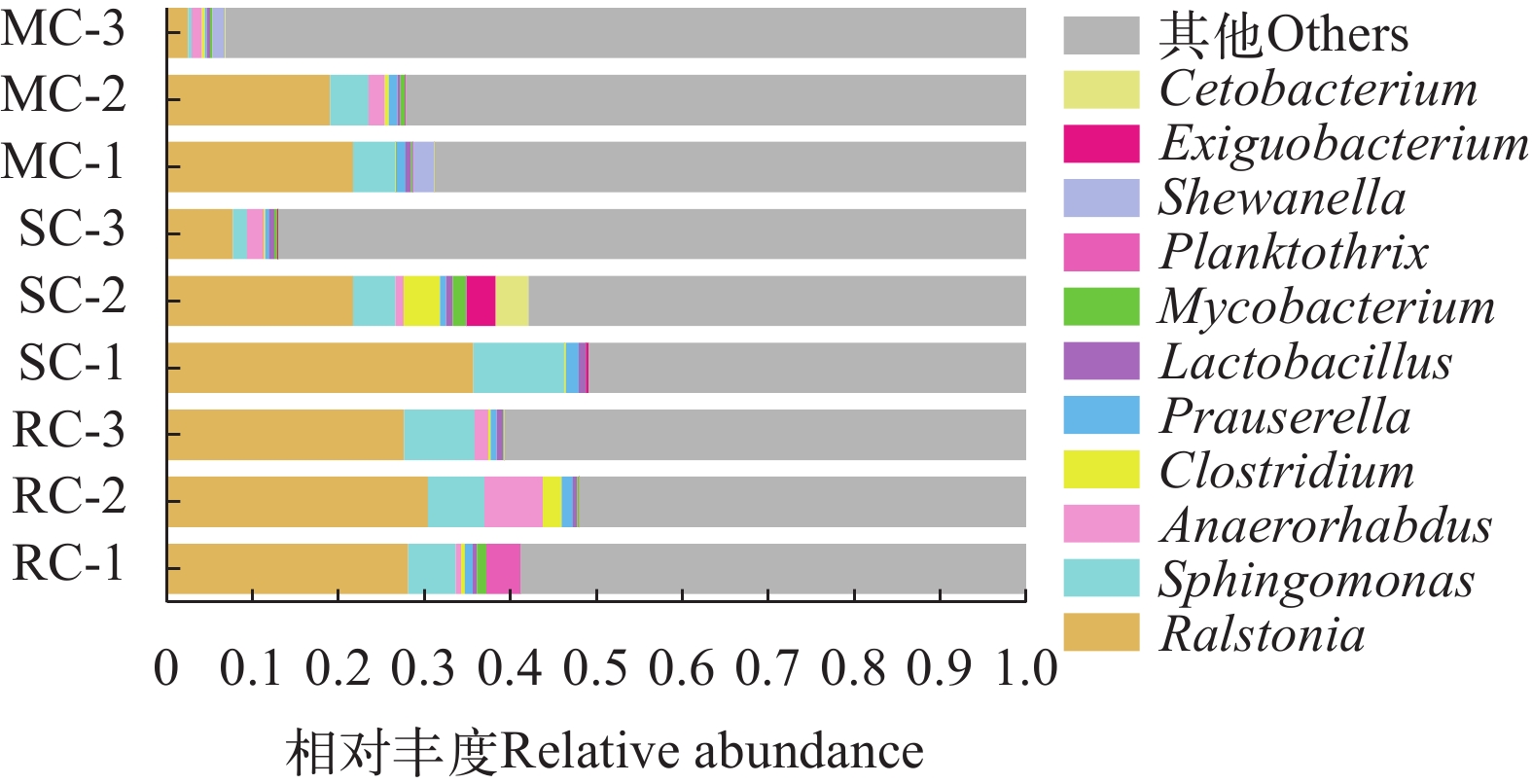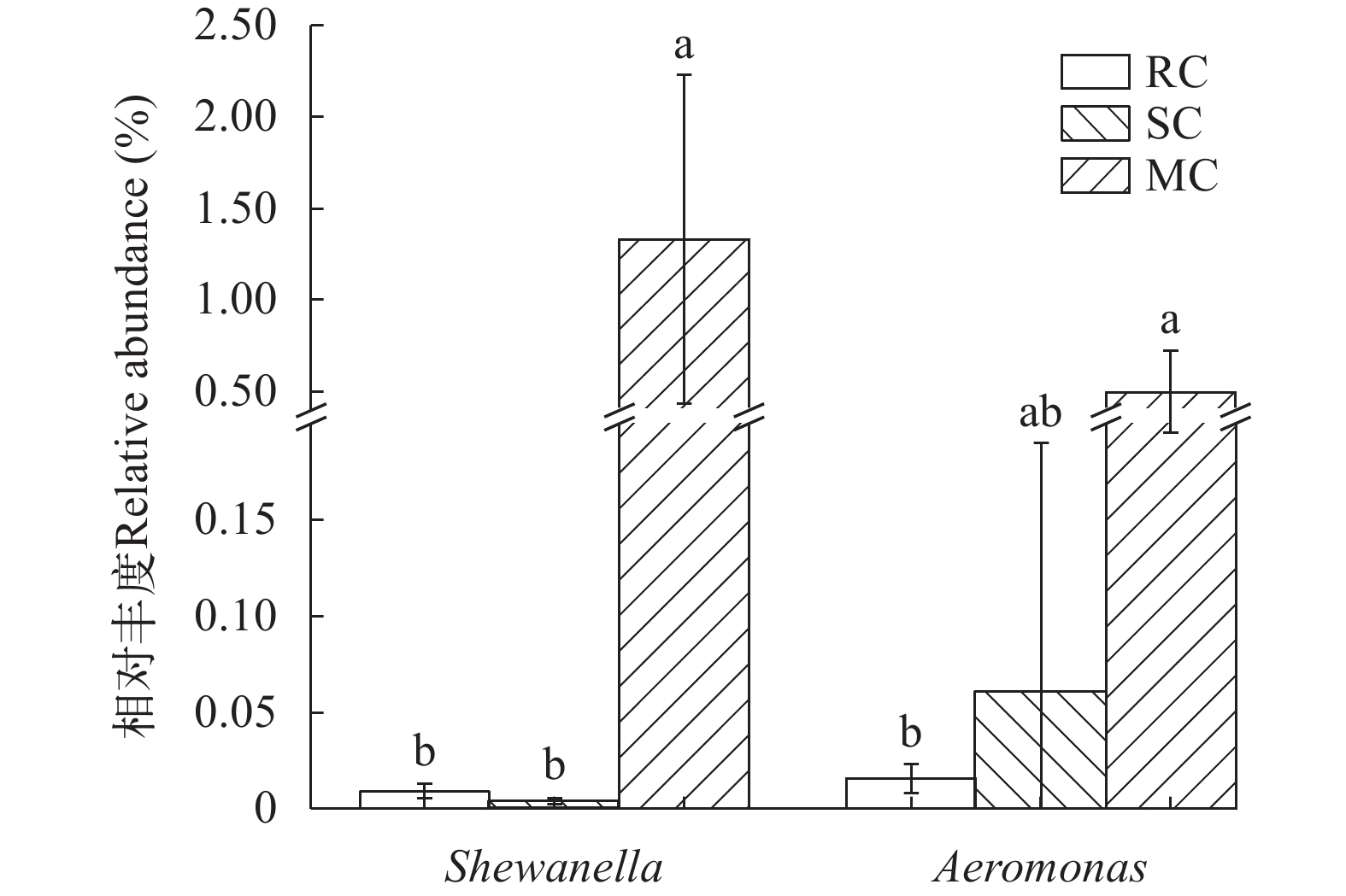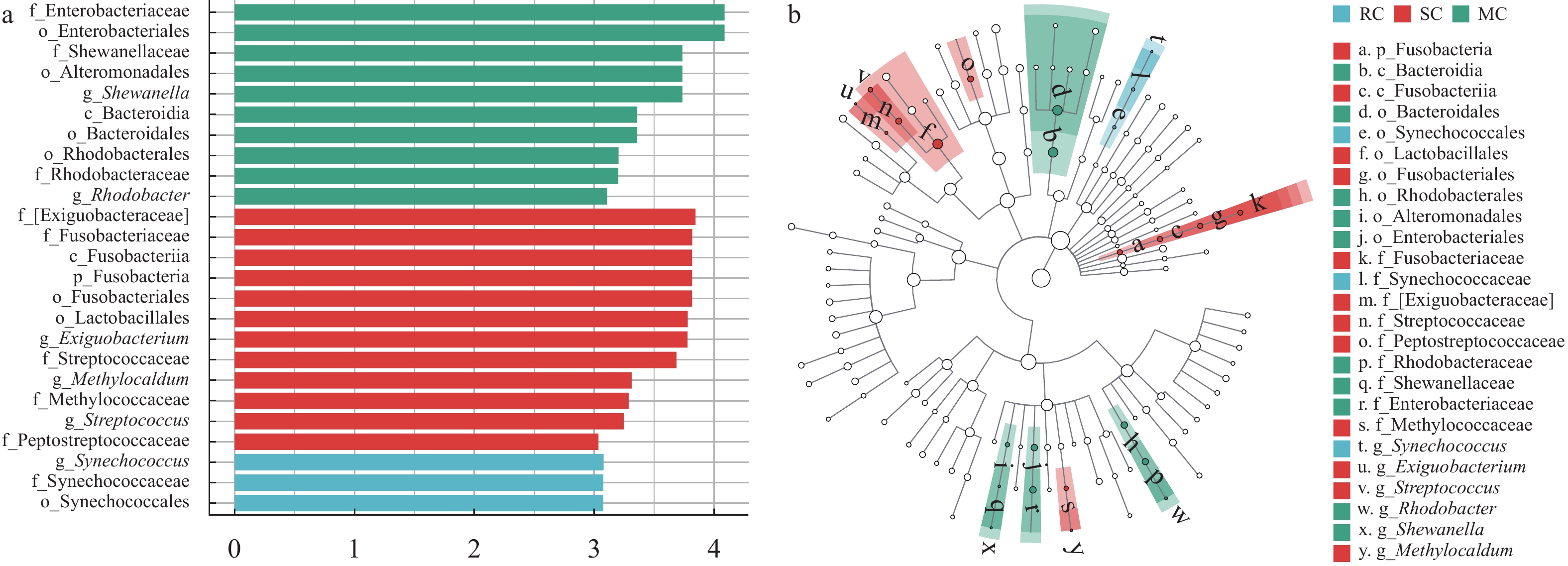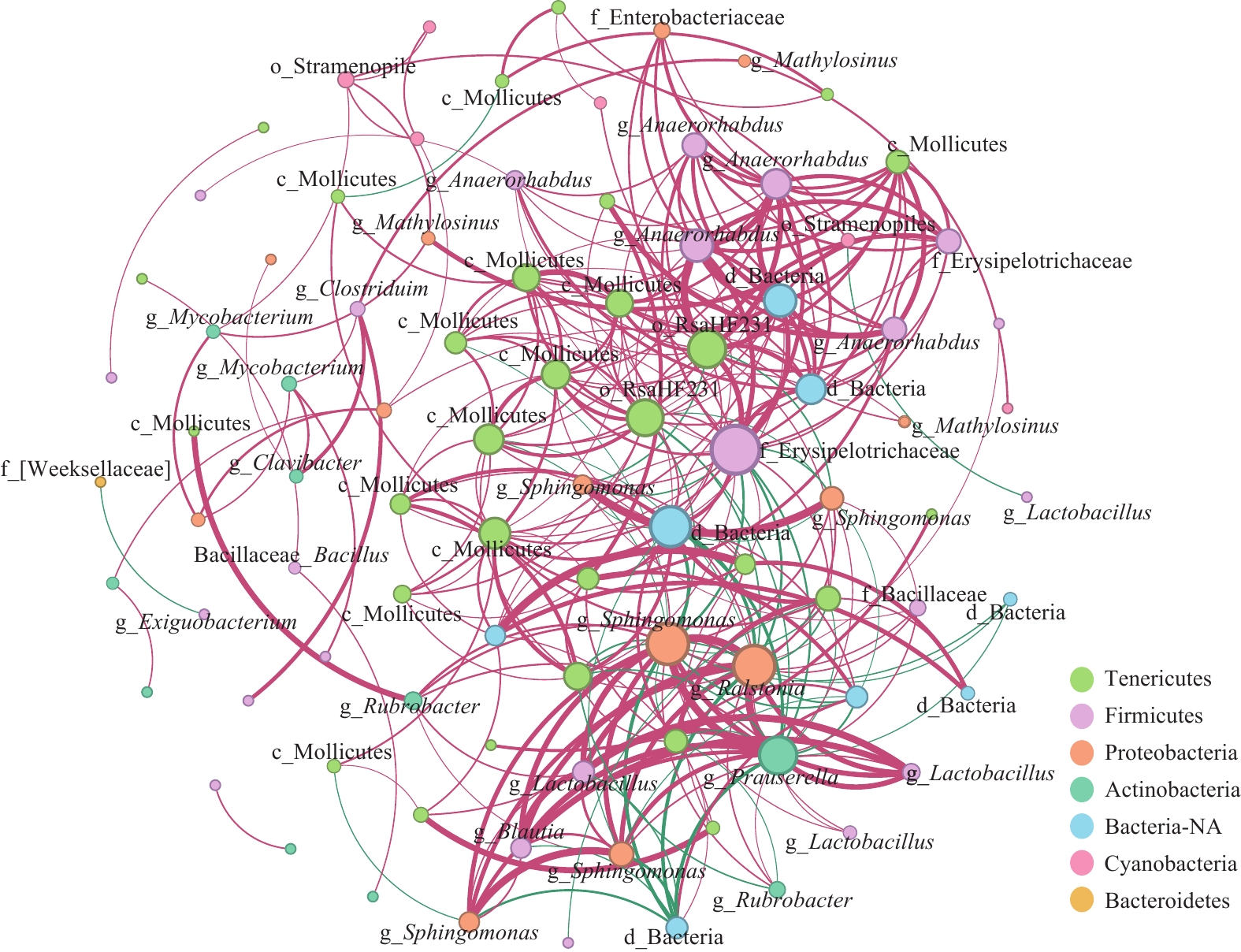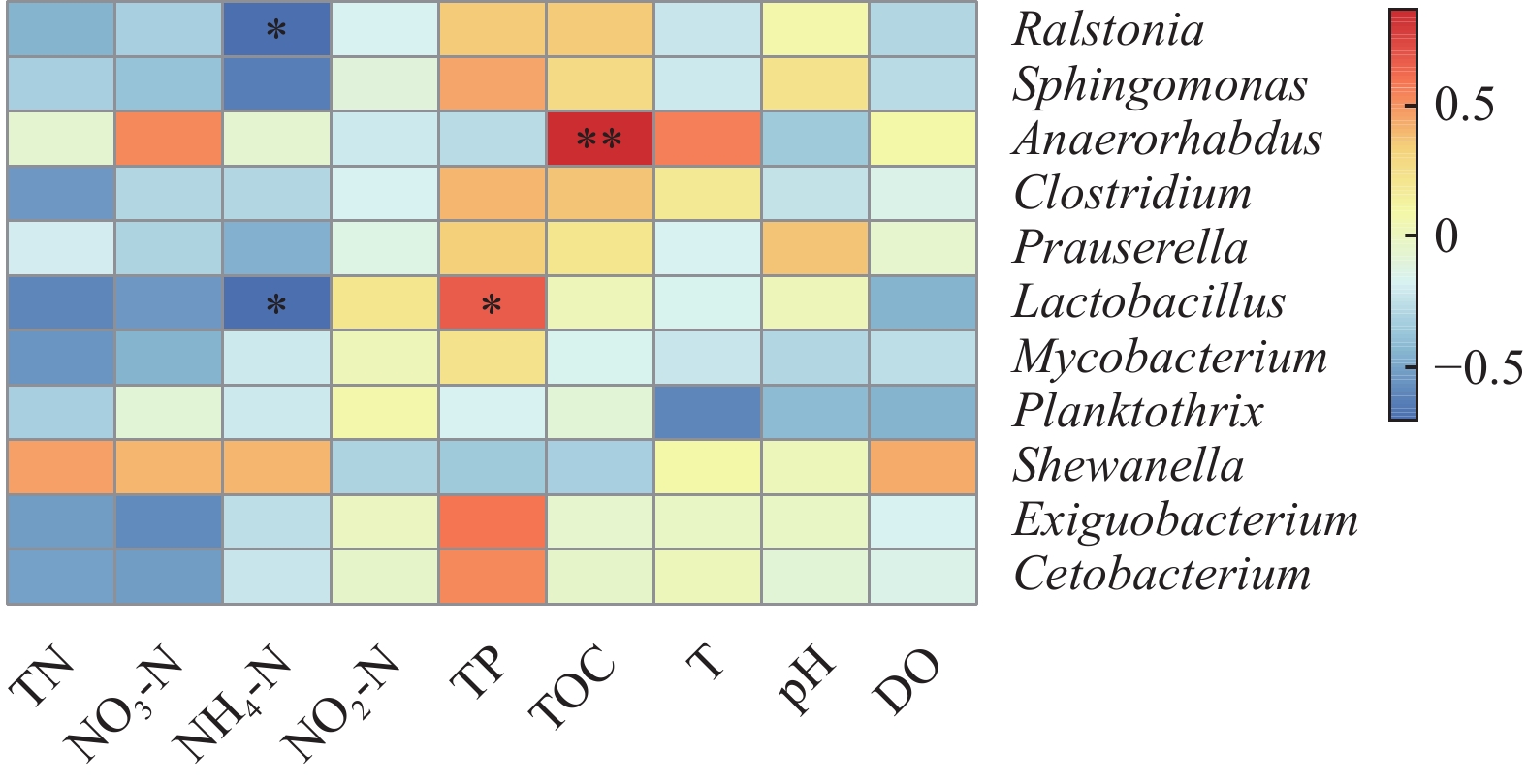COMPARATIVE STUDY ON INTESTINAL MICROBIOTA OF CRAYFISH (PROCAMBARUS CLARKII) IN DIFFERENT CULTURE MODELS
-
摘要:
为了探究不同养殖模式下克氏原螯虾肠道微生物结构与功能是否存在差异, 研究利用Illumina MiSeq高通量测序技术, 测定了稻虾种养(Rice-crayfish co-culture, RC)、池塘单养(Single-crayfish pond culture, SC)和池塘混养(Mixed-crayfish pond culture, MC)模式下克氏原螯虾肠道微生物16S rDNA基因V3—V4区, 解析了肠道菌群组成、结构与功能, 同时探究了肠道细菌之间及其与水体理化因子之间的关系。结果发现: 肠道微生物物种组成方面, 在门水平上, 不同养殖模式克氏原螯虾肠道细菌组成较为一致, 柔壁菌门(Tenericutes)、变形菌门(Proteobacteria)和厚壁菌门(Firmicutes)是绝对优势类群; 在属水平上, 不同养殖模式之间存在一定差异, 芽孢杆菌属(Bacillus)、乳球菌属(Lactococcus)和气单胞菌属(Aeromonas)细菌相对丰度分别在RC、SC和MC组最高。肠道微生物多样性方面, MC组肠道细菌物种丰富度和多样性最高, 三种养殖模式下克氏原螯虾肠道细菌的群落结构存在显著性差异。肠道微生物功能方面, RC组显著富集维生素生物合成代谢通路, SC组显著富集乳糖降解和半乳糖降解代谢通路, MC组显著富集脂肪酸和脂质降解、CMP-pseudaminate生物合成和脂多糖生物合成的超途径代谢通路。肠道微生物之间及其与水体理化因子之间关系方面, 肠道细菌之间的合作关系占比达83.76%, 丹毒丝菌科(Erysipelotrichaceae)和鞘氨醇单胞菌属(Sphingomonas)细菌是网络主要节点; 肠道中乳杆菌属(Lactobacillus)细菌丰度与水体中TP浓度呈显著正相关关系, 与${\rm{NH}}^+_4 $-N浓度呈显著负相关关系。综上, 克氏原螯虾肠道具有特有的以柔壁菌门、变形菌门和厚壁菌门为主的核心微生物类群, 不因养殖模式改变而变化, 但在不同养殖模式下克氏原螯虾肠道细菌群落结构与代谢功能存在显著差异, 该结果丰富了对克氏原螯虾肠道微生物的认识, 为克氏原螯虾肠道益生菌的筛选及其在生产实践中的应用提供了理论依据。
Abstract:The red swamp crayfish (Procambarus clarkii) is the most extensively farmed crustacean in China. The intestinal microbiota plays a crucial role in host physiological functions. However, it remains unclear whether there are differences in intestinal microbiota structure and function among different culture models of crayfish. In this study, we utilized Illumina MiSeq high-throughput sequencing technology to analyze the intestinal microbiota of crayfish under different cultivation models: rice-crayfish co-culture (RC), single-crayfish pond culture (SC), and mixed-crayfish pond culture (MC). We also analyzed water physicochemical factors and further explored the relationship between intestinal microbiota and physicochemical factors in the water. The results revealed that: Species composition analysis showed that at phylum level, the intestinal microbiota composition was consistent across three culture models, with Tenericutes, Proteobacteria, and Firmicutes as the absolute dominant groups. At genus level, there were some differences among different culture models, with Bacillus having the highest relative abundance in RC group, Lactococcus dominated in SC group, and Aeromonas was most abundant in MC group. Diversity analysis showed that the species richness and diversity of intestinal bacteria in group MC were the highest, and there were significant differences in the community structure of intestinal bacteria of crayfish under three culture models. Functional prediction showed that Vitamin Biosynthetic metabolic pathway was significantly enriched in RC group, while lactose degradation and galactose degradation metabolic pathways were prominent in SC group. In the MC group, pathways related to fatty acid and lipid degradation, CMP-pseudaminate biosynthesis, and superpathway of lipopolysaccharide biosynthesis metabolic pathways were significantly enriched. Network analysis showed that the cooperative relationship accounted for 83.76% of the interactions within the intestinal microbiota, with Erysipelotrichaceae and Sphingomonas bacteria were the main nodes of the network. Furthermore, the abundance of Lactobacillus in the gut was significantly positively correlated with TP concentration and negatively correlated with ${\rm{NH}}^+_4 $-N concentration in the water. In conclusion, the intestinal microbiota of crayfish includes core microbial groups mainly composed of Tenericutes, Proteobacteria and Firmicutes in the gut of crayfish, which remain stable across different culture models. However, there are notable variations in both community structure and metabolic function of intestinal bacteria among the three models. These findings enhance our understanding of crayfish intestinal microbiota and provide a theoretical basis for the screening of intestinal probiotics and their application in production practice.
-
Keywords:
- Intestinal microbiota /
- Culture mode /
- Physicochemical factor /
- Crayfish
-
克氏原螯虾(Procambarus clarkii)俗称小龙虾, 原产于墨西哥北部和美国中部, 于20世纪20、30年代从日本引入我国[1, 2]。克氏原螯虾适应能力和繁殖力强, 目前其种群已从我国江苏省南京市扩大到全国各地[3—5]。由于其生长速度快, 经济效益好, 因而被广泛养殖[6], 目前已经成为我国第一大甲壳类养殖品种、第四大淡水养殖品种, 2023年我国克氏原螯虾养殖面积达19667 km2, 产量达3161000吨[7]。
我国克氏原螯虾的养殖模式有稻虾种养、池塘养殖、大水面增养殖、藕田养殖等[7], 稻虾种养是将克氏原螯虾养殖业与水稻种植业有机结合, 充分利用稻田资源, 互利共生[8—10]。池塘养殖包括池塘单养和池塘混养两种模式, 其中, 池塘单养是通过在池塘中种植多种水草, 只养殖克氏原螯虾, 生产过程中轮捕轮放, 全年可收[11, 12]; 池塘混养是将克氏原螯虾与鱼类或蟹类混养, 充分利用池塘的养殖空间, 实现良性循环[13, 14]。目前我国克氏原螯虾主要养殖模式是稻虾种养和池塘养殖模式, 2023年我国稻虾种养养殖面积达16867 km2, 占总养殖面积的85.76%; 池塘养殖面积达2000 km2, 占10.17%[7]。然而, 随着克氏原螯虾养殖面积大幅增加, 养殖产量不断提高, 营养和疾病防控等问题逐渐成为克氏原螯虾行业发展亟需解决的问题。
动物的胃肠道中存在复杂且处于动态平衡的菌群。哺乳动物中的研究发现, 肠道微生物可以调节肠道环境, 促进肠道微生态系统平衡; 促进宿主营养物质消化与吸收; 刺激免疫反应, 提高宿主抗病力; 在宿主的营养代谢和疾病防控中发挥重要作用[15—17]。鱼类中的研究发现, 肠道微生物可以通过接收肠道免疫细胞发送的信号, 调节机体免疫力, 包括调节免疫组织的成熟、抗体的产生、T细胞的分化和巨噬细胞吞噬反应的激活, 从而有效调节鱼类的先天性和适应性免疫反应, 预防疾病发生[18—21]。甲壳动物中的研究发现, 肠道细菌可以分泌多种消化酶, 促进南美白对虾(Litopenaeus vannamei)对食物的消化与吸收[22]; 肠道微生物群的稳定还可以抵抗病原菌的感染, 提高对虾的抗病力[23, 24]; 患病南美白对虾的肠道细菌群落结构发生显著变化, 细菌的代谢途径和功能也显著不同[25]。克氏原螯虾虽然是我国第一大甲壳类养殖品种, 但与鱼类和南美白对虾等其他重要水生经济养殖动物相比, 其肠道微生物研究还不多, 目前研究发现肠道微生物是克氏原螯虾降解纤维素和半纤维素的主要驱动力[26], 在饲料中添加酿酒酵母能够改善克氏原螯虾的生长性能、肠道菌群结构, 提高克氏原螯虾对病原菌的抵抗力[27]。相关研究对克氏原螯虾肠道微生物结构与功能的研究还不充分, 特别是目前克氏原螯虾肠道微生物研究主要集中在稻虾种养和池塘单养模式, 池塘混养模式的研究处于空白状态。对于在不同养殖模式下克氏原螯虾肠道微生物结构与功能是否存在差异也不清晰。
本研究利用Illumina MiSeq高通量测序技术, 解析了稻虾种养、池塘单养和池塘混养[与沙塘鳢(Odontobutis obscurus)混养]三种养殖模式下克氏原螯虾肠道微生物的结构与功能; 同时探究了肠道细菌之间及其与水体理化因子之间的相互作用关系, 以期揭示不同养殖模式下克氏原螯虾肠道微生物的结构与功能是否存在差异, 并为克氏原螯虾肠道益生菌的筛选及其在生产实践中的应用提供理论依据。
1. 材料与方法
1.1 克氏原螯虾肠道样品采集
2022年5月中旬, 分别采集湖北省黄冈市蕲春县鸿汇生态农业发展有限公司(稻虾种养, RC, 30°18′29″N, 115°27′1″E, 正常投喂饲料)、鄂州市鄂城区牛尾农业有限公司(池塘单养, SC, 30°23′42″N, 114°46′41″E, 正常投喂饲料)和武汉市蔡甸区周渔农业生态有限公司(池塘混养, MC, 30°22′55″N, 113°47′29″E; 与肉食性鱼类沙塘鳢混养, 未投喂饲料)三个养殖场的克氏原螯虾成虾, 每个养殖场选取3口(块)池塘(稻田)。将克氏原螯虾带回实验室, 使用浓度为100 mg/L的三卡因甲磺酸盐(MS-222, Sigma, 美国)对其进行麻醉处理。接着在无菌条件下, 取出虾的整个肠道, 挤出内容物并装入无菌EP管中, 每口(块)池塘(稻田)采集5尾虾, 每种养殖模式共15个样品, 置于–80℃保存。
1.2 水样采集与水质指标测定
使用多参数水质测量仪(意大利 HANNA HI98194)测定水面下50 cm处的水温(T)、pH和溶解氧(DO)。每口(块)池塘(稻田)选取5个采样点, 使用采水器采集水样并混合, 保存1 L水样于水样袋中, 置于车载便携式冰箱, –20℃条件下运回实验室。在实验室测定水样的总氮(TN)、总磷(TP)、氨氮(${\rm{NH}}^+_4 $-N)、亚硝酸盐氮(${\rm{NO}}^-_2 $-N)、硝酸盐氮(${\rm{NO}}^-_3 $-N)和总有机碳(TOC)共6个理化因子指标[28, 29]。
1.3 DNA提取、PCR扩增及高通量测序
使用MagBeads FastDNA Kit for Soil (MP Biomedicals, 美国)试剂盒提取样品总基因组DNA, DNA样品经琼脂糖凝胶电泳检测完整性, Nanodrop NC2000 (Thermo Scientific, 美国)超微量分光光度计测定纯度和浓度, 于–20℃保存。
使用细菌16S rDNA V3—V4高度可变区特异性引物338F (5′-ACTCCTACGGGAGGCAGCAG-3′)和806R(5′-GGACTACHVGGGTWTCTAAT-3′)进行PCR扩增。反应体系(25 μL): 1 μL上游引物(10 μmol/L)、1 μL下游引物(10 μmol/L)、2 μL DNA (20 ng)模板、2 μL dNTPs (2.5 mmol/L)、5 μL reaction buffer (5×)、5 μL High GC buffer (5×)、0.25 μL Q5high-fidelity DNA Polymerase和8.75 μL ddH2O。反应程序: 98℃ 2min, 98℃ 15s, 55℃ 30s, 72℃ 30s, 27个循环; 最后72℃延伸5min。目标产物经2%琼脂糖凝胶电泳及AxyPrep DNA凝胶回收试剂盒(Axygen, 美国)进行回收。使用Quant-iT PicoGreen dsDNA Assay Ki试剂盒(Invitrogen, 美国)和酶标仪(FLx800, BioTek, 美国)对目标产物进行定量。在建立文库后, 经Agilent High Sensitivity DNA Kit (Agilent, 美国)和Agilent 2100 Bioanalyzer生物测定仪(Agilent, 美国)进行质检, 并用试剂盒进行定量。最后在Illumina MiSeq (Illumina, 美国)平台使用MiSeq Reagent Kit V3 (600 cycles)试剂盒进行2×250 bp的双端测序。以上实验操作均在上海派森诺生物技术有限公司完成。本研究中所有样本的原始测序数据已存入NCBI的Sequence Read Archive数据库, SRA登录号为PRJNA1181751。
1.4 数据处理与分析
使用DADA2方法, 对测序得到的序列进行去引物、质量过滤、去噪、拼接和去嵌合体等步骤, 获得扩增子序列变体(Amplicon sequence variants, ASVs)[30]。使用QIIME2软件(2019.4)的classify-sklearn算法, 利用q2-feature-classifier插件进行分类赋值, 以Greengenes (Rlease 13.8, https://greengenes.secondgenome.com)为参考数据库进行物种注释[31, 32]。使用QIIME2软件计算Alpha多样性指数[33], 以评估不同养殖模式是否显著影响克氏原螯虾肠道细菌的物种丰富度和多样性。计算Jaccard距离矩阵, 进行主坐标分析(Principal coordinates analysis, PCoA), 调用R语言vegan包的adonis函数进行多元方差分析(Permutational multivariate analysis of variance, PERMANOVA)[34], 评估不同养殖模式是否显著影响克氏原螯虾肠道细菌的群落结构。将非参数的Kruskal-Wallis、Wilcoxon秩和检验与线性判别分析(Linear discriminant analysis, LDA)效应量(Effect size)相结合进行LEfSe分析(LDA effect size)[35], 寻找不同养殖模式之间差异显著物种。使用PICRUSt2软件, 参考MetaCyc数据库(https://metacyc.org/)进行肠道细菌功能预测分析[36]。使用R语言和gephi软件进行关联网络分析及绘图[37]。使用R语言对属水平上丰度较高的细菌和水体理化因子指标进行相关性分析[38]。
使用SPSS 27.0进行数据统计与分析, 两组间统计分析均使用独立样本t检验(Student’s t test)或Mann-Whitney检验, 三组间统计分析均使用单因素方差分析(One-way ANOVA)或Kruskal-Wallis检验, 数据均以平均值±标准差(mean±SD)来表示, P<0.05表示差异显著。使用origin和R语言工具制作物种组成图、柱状图、分支图和热图。
2. 结果
2.1 不同养殖模式克氏原螯虾肠道细菌物种组成分析
在门水平上, 不同养殖模式下克氏原螯虾肠道细菌组成较为一致, 主要由柔壁菌门(Tenericutes)、变形菌门(Proteobacteria)、厚壁菌门(Firmicutes)、放线菌门(Actinobacteria)和拟杆菌门(Bacteroidetes)组成(图 1)。其中, 柔壁菌门、变形菌门和厚壁菌门是RC、SC和MC三种养殖模式克氏原螯虾肠道的绝对优势菌门, 三者丰度之和分别占肠道细菌总数的86.03%、88.33%和87.01%。RC组克氏原螯虾肠道细菌中变形菌门(40.20±33.02)%丰度最高, 其次是柔壁菌门(34.94±28.23)%和厚壁菌门(10.89±13.46)%; 而SC和MC组克氏原螯虾肠道细菌中柔壁菌门(43.64±28.43)%、(54.56±24.34)%丰度最高, 其次是变形菌门(31.87±26.79)%、(26.37±25.63)%和厚壁菌门(12.82±13.61)%、(6.07±6.99)%。统计分析发现, 在不同养殖模式下以上相同门的肠道细菌丰度均不存在显著性差异(P≥0.05)。另外, 在三种养殖模式下均未发现RsaHF231门细菌, 相对丰度为0。
![]() 图 1 不同养殖模式克氏原螯虾肠道细菌门水平组成每根柱子代表一个池塘/稻田, 门水平上相对丰度取每个池塘/稻田中5个重复的平均值; RC. 稻虾种养模式; SC. 池塘单养模式; MC. 池塘混养模式; 下同Figure 1. Intestinal bacteria composition of Procambarus clarkii in different culture models at phylum levelEach column represents a pond/paddy, the relative abundance at phylum level is taken as the mean of the 5 replicates in each pond/paddy; RC. rice-crayfish co-culture; SC. single-crayfish pond culture; MC. mixed-crayfish pond culture; The same applies below
图 1 不同养殖模式克氏原螯虾肠道细菌门水平组成每根柱子代表一个池塘/稻田, 门水平上相对丰度取每个池塘/稻田中5个重复的平均值; RC. 稻虾种养模式; SC. 池塘单养模式; MC. 池塘混养模式; 下同Figure 1. Intestinal bacteria composition of Procambarus clarkii in different culture models at phylum levelEach column represents a pond/paddy, the relative abundance at phylum level is taken as the mean of the 5 replicates in each pond/paddy; RC. rice-crayfish co-culture; SC. single-crayfish pond culture; MC. mixed-crayfish pond culture; The same applies below在属水平上, 将未分类属和不明属归为其他类群, 罗尔斯通氏菌属(Ralstonia)、鞘氨醇单胞菌属(Sphingomonas)、棍状厌氧菌属(Anaerorhabdus)、梭菌属(Clostridium)和普劳瑟尔氏菌属(Prauserella)是RC、SC和MC三种模式下克氏原螯虾肠道的主要细菌类群(图 2)。在相对丰度小于1.5%的细菌类群中, RC组芽孢杆菌属(Bacillus)丰度最高(0.39±0.33)%; SC组鲸杆菌属(Cetobacterium)、乳杆菌属(Lactobacillus)和乳球菌属(Lactococcus)丰度均最高(1.26±2.17)%、(0.70±0.14)%和(0.37±0.58)%。统计发现, 在不同养殖模式下希瓦氏菌属(Shewanella)和气单胞菌属(Aeromonas)丰度存在显著性差异, 且均在MC组最高[(1.33±1.23)%和(0.50±0.58)%, P<0.05; 图 3]。
![]() 图 3 不同养殖模式克氏原螯虾肠道中希瓦氏菌属和气单胞菌属细菌相对丰度不同字母表示各组之间在P<0.05水平上有显著性差异, 含有相同字母则差异不显著Figure 3. Relative abundance of Shewanella and Aeromonas in intestinal of Procambarus clarkii in different culture modelsDifferent letters indicate significant difference at the P<0.05 level, while the same letters show no significant difference
图 3 不同养殖模式克氏原螯虾肠道中希瓦氏菌属和气单胞菌属细菌相对丰度不同字母表示各组之间在P<0.05水平上有显著性差异, 含有相同字母则差异不显著Figure 3. Relative abundance of Shewanella and Aeromonas in intestinal of Procambarus clarkii in different culture modelsDifferent letters indicate significant difference at the P<0.05 level, while the same letters show no significant difference2.2 不同养殖模式克氏原螯虾肠道细菌多样性分析
在不同养殖模式下, 克氏原螯虾肠道细菌的Alpha多样性指数在统计学上均无显著性差异(P≥0.05; 表 1)。MC组克氏原螯虾肠道细菌的Chao1和Observed species指数均高于RC组(TChao1=1.409, P≥0.05; TObserved species=1.342, P≥0.05)和SC组(TChao1=0.730, P≥0.05; ZObserved species= –0.975, P≥0.05); MC组克氏原螯虾肠道细菌的Shannon指数也略高于RC组(TShannon=0.450, P≥0.05)和SC组(TShannon=0.131, P≥0.05)。整体上, 肠道细菌群落物种丰富度和多样性最高的为MC组(Chao1=698.47±244.55, Observed species=619.56±230.90, Shannon=4.01±1.18), 最低的为RC组(Chao1=571.73±247.96, Observed species=505.56±234.43, Shannon=3.81±1.34)。
表 1 不同养殖模式克氏原螯虾肠道细菌Alpha多样性指数Table 1. Intestinal bacterial Alpha diversity index of Procambarus clarkii in different culture models组别
Group物种丰富度
Species richness物种多样性
Species diversityChao1指数
Chao1 indexObserved
species指数
Observed species indexShannon指数
Shannon index稻虾种养RC 571.73±247.96 505.56±234.43 3.81±1.34 池塘单养SC 627.20±288.52 560.72±282.00 3.95±1.31 池塘混养MC 698.47±244.55 619.56±230.90 4.01±1.18 注: 表中数据为15个重复的平均值, 以平均值±标准差表示; 同一列数据右上角无上标字母表示无显著性差异(P≥0.05)Note: Data in the table are means of 15 replicates, present as the mean±standard deviation; No marked letter in the upper right corner of the same column indicates no significant difference (P≥0.05) 基于Jaccard距离矩阵进行PCoA分析(即Beta多样性分析), 结果表明不同养殖模式克氏原螯虾肠道细菌彼此分开并各自聚在一起(图 4)。进一步PERMANOVA分析表明, RC和SC组克氏原螯虾肠道细菌群落结构存在显著差异(F=1.259, P<0.05), RC与MC组克氏原螯虾肠道细菌群落结构存在显著差异(F=1.577, P<0.01), SC与MC组克氏原螯虾肠道细菌群落结构也存在显著差异(F=1.377, P<0.01)。
2.3 不同养殖模式克氏原螯虾肠道差异物种分析
利用LEfSe分析寻找不同养殖模式下克氏原螯虾肠道中的差异细菌分类单元, 共区分出1404个细菌分类单元, 当LDA阈值设为3时, 共筛选出25个丰度存在显著性差异的分类单元(P<0.05), 其中RC组有3个, SC组有12个, MC组有10个(图 5)。RC组显著富集的分类单元最少, 主要是蓝细菌门的聚球藻菌属(Synechococcus); SC组中显著富集的分类单元最多, 主要包括厚壁菌门的微小杆菌属(Exiguobacterium)、乳杆菌目(Lactobacillales), 梭杆菌门的梭杆菌科(Fusobacteriaceae)等。MC组显著富集的分类单元包括γ-变形菌纲的肠杆菌目(Enterobacteriales)、交替单胞菌目(Alteromonadales), α-变形菌纲的红细菌属(Rhodobacter)等。
2.4 不同养殖模式克氏原螯虾肠道细菌功能预测分析
参考MetaCyc数据库, 进行克氏原螯虾肠道细菌PICRUSt功能预测分析。克氏原螯虾肠道细菌的主要功能: 生物合成(Biosynthesis)、降解/利用/同化(Degradation/Utilization/Assimilation)、前体代谢物和能量产生(Generation of precursor metabolite and energy)、聚糖途径(Glycan pathways)、分子修饰(Macromolecule modification)和代谢簇(Metabolic clusters)共6个一级功能通路。进一步筛选一级功能通路下的二级功能类群, 寻找不同养殖模式下存在差异的肠道细菌代谢通路。统计分析发现, 维生素生物合成(Vitamin biosynthesis)代谢通路在RC组显著富集; 乳糖降解(Lactose Degradation)和半乳糖降解(Galactose degradation)代谢通路在SC组显著富集; 核苷和核苷酸降解(Nucleoside and nucleotide degradation)、脂肪酸和脂质降解(Fatty acid and lipid degradation)、甘氨酸甜菜碱降解(Glycine betaine degradation)、CMP-pseudaminate生物合成(CMP-pseudaminate biosynthesis)、脂多糖生物合成的超途径(Superpathway oflipopolysaccharide biosynthesis)代谢通路在MC组显著富集(P<0.05; 图 6)。
2.5 克氏原螯虾肠道细菌之间、细菌与水体理化因子之间相互作用分析
关联网络分析可以显示克氏原螯虾肠道细菌之间相互作用关系。整个关联网络由180个节点和314个边构成, 模块化系数达到0.507, 克氏原螯虾肠道细菌之间的关系较为复杂(|r|>0.4; P<0.05), 但以显著正相关关系为主, 在整个网络中的占比高达83.76%。其中, 鞘氨醇单胞菌属、罗尔斯通氏菌属、普劳瑟尔氏菌属、乳杆菌属和经黏液真杆菌属(Blautia)细菌之间, 柔膜菌纲(Mollicutes)、RsaHF231目、丹毒丝菌科(Erysipelotrichaceae)和棍状厌氧菌属细菌之间形成了网络中两个正相关关系较强的部分。此外, 克氏原螯虾肠道细菌之间也存在显著负相关关系, 占比为16.24%, 以未知门的细菌为中心, 向外扩展, 与罗尔斯通氏菌属、普劳瑟尔氏菌属、鞘氨醇单胞菌属细菌共同形成网络中主要的负相关关系部分(图 7)。
属水平肠道细菌与水体理化因子的相关性分析发现, 大部分细菌与理化因子之间的相关关系不显著, 仅少数存在显著相关关系。其中, 乳杆菌属细菌丰度与水体中TP浓度呈显著正相关关系, 与${\rm{NH}}^+_4 $-N浓度呈显著负相关关系(P<0.05); 棍状厌氧菌属细菌丰度与水体中TOC浓度呈显著正相关关系(P<0.01; 图 8)。
3. 讨论
3.1 不同养殖模式克氏原螯虾肠道细菌组成、结构与功能
肠道微生物与宿主共进化, 已成为宿主不可分割的一部分, 发挥着重要的生理功能, 并且不同物种形成了与宿主相关的特有核心菌群[39, 40]。前期研究发现, 柔壁菌门、变形菌门和厚壁菌门是稻虾种养和池塘单养模式下克氏原螯虾肠道中的优势菌群[41—43]。本文结果与前人研究一致, 柔壁菌门、变形菌门和厚壁菌门在不同养殖模式下克氏原螯虾肠道中的丰度之和超过肠道细菌总数的86.03%, 是肠道核心菌群。柔壁菌门也存在于其他甲壳动物肠道中, 如斑节对虾(Penaeus monodon)[44]、罗氏沼虾(Macrobrachium rosenbergii)[45]、凡纳滨对虾(Litopenaeus vannamei)[46]、红鳌鳌虾(Cherax quadricarinatus)[43]和中华绒螯蟹(Eriocheir sinensis)[47]等, 其可能是甲壳动物肠道内的常见共生菌[48]。柔壁菌门通常也被认为是克氏原螯虾肠道核心微生物类群[49], 但邓祥宜等[50]认为柔壁菌门丰度受环境影响很大。本研究对不同地点不同养殖模式克氏原螯虾肠道菌群组成的研究发现, 柔壁菌门丰度最高达到54.56%, 最低也有34.94%, 此外, Shui等[42]和Chen等[43]也分别发现柔壁菌门在克氏原螯虾肠道中的丰度达到了67.35%和56.13%, 因此本研究认为柔壁菌门是克氏原螯虾肠道核心微生物类群。除柔壁菌门、变形菌门和厚壁菌门之外, 有研究认为RsaHF231门是克氏原螯虾肠道的核心菌群[49], 但克氏原螯虾肠道中RsaHF231门的丰度变化很大, 在0[51]、5.8%[52]、5.95%[53]、7.90%[49]、17.99%[54]和35.70%[54]之间, 本研究我们发现不同养殖模式克氏原螯虾肠道中RsaHF231门相对丰度均为0, 而在丰度较高的7.90%[49]、17.99%[54]和35.70%[54]研究中, 作者都认为其丰度受食物的影响很大, 因此推测RsaHF231门不是克氏原螯虾肠道的核心类群。
有益菌和条件致病菌是肠道中常见类群, 它们共同构成了复杂、平衡的肠道微生态系统[55]。芽孢杆菌属、乳杆菌属和乳球菌属细菌是水产养殖中常用益生菌[56]。本研究结果显示, 稻虾种养和池塘单养模式克氏原螯虾肠道中芽孢杆菌属、乳杆菌属和乳球菌属细菌的丰度高于池塘混养模式。在本研究中, 采样的稻虾种养和池塘单养两种模式中克氏原螯虾的养殖密度大, 养殖过程中投入了大量配合饲料与益生菌产品, 人工干预较多; 而池塘混养模式是克氏原螯虾与沙塘鳢(肉食性鱼类)混养, 克氏原螯虾养殖密度低, 全程没有投喂配合饲料与益生菌产品, 主要利用水体天然饵料养殖, 虾在较为自然的环境下生长。在本研究中, 益生菌丰度存在差异可能与养殖过程中益生菌的使用有关。本研究还发现, 池塘单养模式下克氏原螯虾肠道中鲸杆菌属细菌丰度最高, 鲸杆菌属细菌能增强鱼类糖类利用的能力, 改善鱼类葡萄糖稳态[57], 说明池塘单养模式下克氏原螯虾具有较强的糖类利用能力, 肠道细菌功能预测结果也证实了这一点, 池塘单养模式下克氏原螯虾肠道细菌的乳糖降解和半乳糖降解代谢通路显著富集。但不同养殖模式下克氏原螯虾肠道鲸杆菌属细菌丰度为何存在差异, 还不清楚。变形菌门细菌广泛存在于水生动物肠道中, 该门的许多种类是条件致病菌[58], 例如, 研究发现克氏原螯虾患病与否与肠道中变形菌门细菌丰度存在相关性[59]。在本研究中, 变形菌门中的气单胞菌属细菌的相对丰度在不同养殖模式中存在显著差异, 在池塘混养模式中丰度最高。气单胞菌属细菌如豚鼠气单胞菌(Aeromonas cavive)、嗜水气单胞菌(Aeromonas hydrophila)和维氏气单胞菌(Aeromonas veronii)等的感染能够引起克氏原螯虾大规模死亡[60—62]。据此, 本文推测这种自然养殖状态可能成为条件致病菌的病原库, 存在疾病传播与暴发的风险。在实际生产过程中, 池塘混养模式下应重点开展克氏原螯虾的病原监测, 避免因疾病暴发造成损失。
前期研究发现, 在稻虾种养和池塘单养模式下, 克氏原螯虾肠道细菌Alpha多样性指数差异不显著[63], 本研究的结果也证实了这一点。本研究发现稻虾种养、池塘单养和池塘混养三种养殖模式下克氏原螯虾肠道细菌Alpha多样性指数均无显著性差异。尽管Alpha多样性指数没有显著差异, 但Beta多样性分析发现, 三种养殖模式克氏原螯虾肠道细菌群落结构存在显著差异。此外, 功能预测结果也显示, 不同养殖模式克氏原螯虾肠道细菌显著富集的代谢通路存在显著差异, 相较于稻虾种养和池塘单养模式, 池塘混养模式下, 人为干预较少, 克氏原螯虾肠道细菌显著富集了较多代谢通路, 包括脂肪酸和脂质降解、CMP-pseudaminate生物合成和脂多糖生物合成的超途径等, 该模式下克氏原螯虾肠道细菌对食物的消化利用能力可能更强。这些结果说明不同养殖模式克氏原螯虾具有独特的肠道细菌群落结构和代谢功能。
3.2 肠道微生物之间及微生物与环境理化因子之间的关系
动物肠道中存在着复杂且处于动态变化的微生物群落, 微生物之间相互作用, 以维持肠道微生态平衡[64]。关联网络分析可以寻找特定微生物群在时空和环境驱动下所呈现的共现或互斥的固有模式, 物种间相互作用被组织成模块的程度称为网络的模块化, 模块化是生态系统稳定性和群落恢复力的一个重要属性, 可以在一定程度上说明微生物间直接或间接的相互作用[49, 65]。在本研究中, 关联网络的模块化系数为0.507, 表明网络图达到了一定的模块化程度, 克氏原螯虾肠道微生物关联网络中存在有效的模块化结构[66]。此外, 本研究还发现克氏原螯虾肠道细菌之间以合作关系为主, 一些丰度较低的细菌类群可能发挥着重要的作用, 但高丰度的丹毒丝菌科和鞘氨醇单胞菌属细菌是网络图中的主要连接节点。丹毒丝菌科细菌与肠道中丁酸盐的产生有关[67], 丁酸盐具有抗炎特性, 在欧洲鲈(Dicentrarchus labrax)日粮中添加丁酸盐能缓解由豆粕引起的肠道炎症症状[68], 丁酸盐还能通过调节紧密连接蛋进而修复鱼类肠道屏障损伤[69]。鞘氨醇单胞菌属细菌可以改善养殖循环水的水质, 还可以提高中华绒螯蟹的存活率, 提高蟹的产量(重量、放养密度和生物量)和质量(粗蛋白、粗脂肪和含水量)[70]。这些结果说明丹毒丝菌科和鞘氨醇单胞菌属细菌或许可以作为候选益生菌, 应用于克氏原螯虾养殖产业, 以促进克氏原螯虾肠道健康, 提高克氏原螯虾的产量与质量。
水体理化因子与水生动物肠道微生物群落结构密切相关[45, 71]。本研究发现克氏原螯虾肠道中乳杆菌属细菌丰度与养殖水体中TP浓度呈显著正相关关系, 与${\rm{NH}}^+_4 $-N浓度呈显著负相关关系, 乳杆菌属细菌是水产养殖中常用益生菌[72], 推测或许可以通过调节养殖水体水质指标, 调控肠道中乳杆菌属细菌的丰度, 进而维持克氏原螯虾肠道微生态平衡, 发挥乳杆菌属细菌的益生功能。
4. 结论
本文研究了不同养殖模式克氏原螯虾肠道微生物结构与功能, 发现克氏原螯虾肠道中存在着以柔壁菌门、变形菌门和厚壁菌门为主的核心微生物类群, 核心微生物类群不因养殖模式改变而变化, 但不同养殖模式下克氏原螯虾肠道细菌群落结构与代谢功能存在显著差异。该结果丰富了我们对克氏原螯虾肠道微生物的认识, 为克氏原螯虾肠道益生菌的筛选及其在生产实践中的应用提供了理论依据。
致谢:
感谢兰州大学公共卫生学院李欢教授团队在本论文数据分析过程中所提供的帮助。
-
图 1 不同养殖模式克氏原螯虾肠道细菌门水平组成
每根柱子代表一个池塘/稻田, 门水平上相对丰度取每个池塘/稻田中5个重复的平均值; RC. 稻虾种养模式; SC. 池塘单养模式; MC. 池塘混养模式; 下同
Figure 1. Intestinal bacteria composition of Procambarus clarkii in different culture models at phylum level
Each column represents a pond/paddy, the relative abundance at phylum level is taken as the mean of the 5 replicates in each pond/paddy; RC. rice-crayfish co-culture; SC. single-crayfish pond culture; MC. mixed-crayfish pond culture; The same applies below
图 3 不同养殖模式克氏原螯虾肠道中希瓦氏菌属和气单胞菌属细菌相对丰度
不同字母表示各组之间在P<0.05水平上有显著性差异, 含有相同字母则差异不显著
Figure 3. Relative abundance of Shewanella and Aeromonas in intestinal of Procambarus clarkii in different culture models
Different letters indicate significant difference at the P<0.05 level, while the same letters show no significant difference
表 1 不同养殖模式克氏原螯虾肠道细菌Alpha多样性指数
Table 1 Intestinal bacterial Alpha diversity index of Procambarus clarkii in different culture models
组别
Group物种丰富度
Species richness物种多样性
Species diversityChao1指数
Chao1 indexObserved
species指数
Observed species indexShannon指数
Shannon index稻虾种养RC 571.73±247.96 505.56±234.43 3.81±1.34 池塘单养SC 627.20±288.52 560.72±282.00 3.95±1.31 池塘混养MC 698.47±244.55 619.56±230.90 4.01±1.18 注: 表中数据为15个重复的平均值, 以平均值±标准差表示; 同一列数据右上角无上标字母表示无显著性差异(P≥0.05)Note: Data in the table are means of 15 replicates, present as the mean±standard deviation; No marked letter in the upper right corner of the same column indicates no significant difference (P≥0.05) -
[1] 刘其根, 李应森, 陈蓝荪. 克氏原螯虾的生物学 [J]. 水产科技情报, 2008, 35(1): 21-23.] Liu Q G, Li Y S, Chen L S. Ecological culture of red swamp crawfish Procambarus clarkii (Ⅰ) [J]. Fisheries Science & Technology Information, 2008, 35(1): 21-23. [
[2] Li Y, Guo X, Cao X, et al. Population genetic structure and post-establishment dispersal patterns of the red swamp crayfish Procambarus clarkii in China [J]. PLoS One, 2012, 7(7): e40652. doi: 10.1371/journal.pone.0040652
[3] 任妮, 戴红君, 张琤琤, 等. 我国克氏原螯虾产业调查分析与发展对策建议 [J]. 江苏农业科学, 2021, 49(19): 241-246.] Ren N, Dai H J, Zhang C C, et al. Investigation and analysis of China’s crayfish industry and suggestions for development [J]. Jiangsu Agricultural Sciences, 2021, 49(19): 241-246. [
[4] 徐加涛, 阎斌伦, 徐国成. 克氏原螯虾产业发展背景、现状与展望 [J]. 水产科技情报, 2011, 38(4): 172-176.] Xu J T, Yan B L, Xu G C. Development background, present situation and prospect of Procambarus clarkii industry [J]. Fisheries Science & Technology Information, 2011, 38(4): 172-176. [
[5] Yi S, Li Y, Shi L, et al. Characterization of population genetic structure of red swamp crayfish, Procambarus clarkii, in China [J]. Scientific Reports, 2018, 8(1): 5586. doi: 10.1038/s41598-018-23986-z
[6] 但启明. 两种养殖模式对克氏原螯虾食性和肌肉品质的影响 [D]. 武汉: 华中农业大学, 2023: 1.] Dan Q M. Effects of two kinds of breeding systems on feeding habits and meat quality of Procambarus clarkii [D]. Wuhan: Huazhong Agricultural University, 2023: 1. [
[7] 全国水产技术推广总站, 中国水产学会. 中国小龙虾产业发展报告(2024) [J]. 中国水产, 2024(7): 14-20.] National Fisheries Technology Extension Center, China Society of Fisheries. China crayfish industry development report (2024) [J]. China Fisheries, 2024(7): 14-20. [
[8] 陆海莉, 陈小琳, 陈青春, 等. 稻虾生态种养模式下克氏原螯虾养殖优化决策模型 [J]. 水产养殖, 2023, 44(12): 62-64.] Lu H L, Chen X L, Chen Q C, et al. Optimal decision-making model of Procambarus clarkii culture under the ecological breeding mode of rice and shrimp [J]. Journal of Aquaculture, 2023, 44(12): 62-64. [
[9] 奚业文. 低洼稻田稻虾连作、共作生态试验技术分析 [J]. 基层农技推广, 2014, 2(10): 30-33.] Xi Y W. Analysis on ecological experiment technology of rice and shrimp continuous cropping and co-cropping in low-lying paddy fields [J]. Primary Agricultural Technology Extension, 2014, 2(10): 30-33. [
[10] 陈松文, 江洋, 汪金平, 等. 湖北省稻虾模式发展现状与对策分析 [J]. 华中农业大学学报, 2020, 39(2): 1-7.] Chen S W, Jiang Y, Wang J P, et al. Situation and countermeasures of integrated rice-crayfish farming in Hubei Province [J]. Journal of Huazhong Agricultural University, 2020, 39(2): 1-7. [
[11] 花友亮, 朱宏元, 宋长太. 池塘主养小龙虾生产模式与技术 [J]. 农村新技术, 2022(7): 32-33.] Hua Y L, Zhu H Y, Song C T. Production mode and technology of crayfish in pond [J]. New Rural Technology, 2022(7): 32-33. [
[12] 顾明. 小龙虾池塘生态养殖技术 [J]. 现代农业科技, 2021(18): 202-203, 207.] Gu M. Ecological culture technology of crayfish pond [J]. Modern Agricultural Science and Technology, 2021(18): 202-203, 207. [
[13] 宋亮, 张建平, 韩晓磊, 等. 克氏原螯虾养殖现状及对策 [J]. 常熟理工学院学报, 2011, 25(2): 85-87,91.] Song L, Zhang J P, Han X L, et al. Analysis of breeding situation and countermeasures of Procambarus clarkia [J]. Journal of Changshu Institute of Technology, 2011, 25(2): 85-87,91. [
[14] 张聪. 河蟹与小龙虾池塘高效混养技术 [J]. 渔业致富指南, 2024(9): 39-43.] Zhang C. Efficient polyculture technology of river crab and crayfish in pond [J]. Fishery Guide to be Rich, 2024(9): 39-43. [
[15] Gomaa E Z. Human gut microbiota/microbiome in health and diseases: a review [J]. Antonie Van Leeuwenhoek, 2020, 113(12): 2019-2040. doi: 10.1007/s10482-020-01474-7
[16] Heintz-Buschart A, Wilmes P. Human gut microbiome: function matters [J]. Trends in Microbiology, 2018, 26(7): 563-574. doi: 10.1016/j.tim.2017.11.002
[17] Hanning I, Diaz-Sanchez S. The functionality of the gastrointestinal microbiome in non-human animals [J]. Microbiome, 2015(3): 51. doi: 10.1186/s40168-015-0113-6
[18] Roeselers G, Mittge E K, Stephens W Z, et al. Evidence for a core gut microbiota in the zebrafish [J]. The ISME Journal, 2011, 5(10): 1595-1608. doi: 10.1038/ismej.2011.38
[19] Abid A, Davies S J, Waines P, et al. Dietary synbiotic application modulates Atlantic salmon (Salmo salar) intestinal microbial communities and intestinal immunity [J]. Fish & Shellfish Immunology, 2013, 35(6): 1948-1956.
[20] Nayak S K. Role of gastrointestinal microbiota in fish [J]. Aquaculture Research, 2010, 41(11): 1553-1573. doi: 10.1111/j.1365-2109.2010.02546.x
[21] Dawood M A O. Nutritional immunity of fish intestines: important insights for sustainable aquaculture [J]. Reviews in Aquaculture, 2021, 13(1): 642-663. doi: 10.1111/raq.12492
[22] Tzuc J T, Escalante D R, Rojas Herrera R, et al. Microbiota from Litopenaeus vannamei: digestive tract microbial community of Pacific white shrimp (Litopenaeus vannamei) [J]. SpringerPlus, 2014(3): 280. doi: 10.1186/2193-1801-3-280
[23] 王金星. 对虾等甲壳类动物肠道与血淋巴菌群的组成、功能与动态平衡调控 [J]. 微生物学报, 2018, 58(5): 760-772.] Wang J X. The gut and hemolymph microbiotas of crustacean, composition, functions, and homeostatic regulation [J]. Acta Microbiologica Sinica, 2018, 58(5): 760-772. [
[24] Rungrassamee W, Klanchui A, Maibunkaew S, et al. Bacterial dynamics in intestines of the black tiger shrimp and the Pacific white shrimp during Vibrio harveyi exposure [J]. Journal of Invertebrate Pathology, 2016(133): 12-19. doi: 10.1016/j.jip.2015.11.004
[25] Zhu J, Dai W, Qiu Q, et al. Contrasting ecological processes and functional compositions between intestinal bacterial community in healthy and diseased shrimp [J]. Microbial Ecology, 2016, 72(4): 975-985. doi: 10.1007/s00248-016-0831-8
[26] 冯光志, 石慧, 刘博, 等. 小龙虾肠道产纤维素酶细菌的分离与鉴定 [J]. 生物技术通报, 2020, 36(2): 65-70.] Feng G Z, Shi H, Liu B, et al. Screening and identification of cellulase-producing strains isolated from crayfish intestine [J]. Biotechnology Bulletin, 2020, 36(2): 65-70. [
[27] Xu Y, Li Y, Xue M, et al. Effects of dietary Saccharomyces cerevisiae YFI-SC2 on the growth performance, intestinal morphology, immune parameters, intestinal microbiota, and disease resistance of crayfish (Procambarus clarkia) [J]. Animals, 2021, 11(7): 1963. doi: 10.3390/ani11071963
[28] 中国环境监督总站, 辽宁省环境监测中心站. HJ 494-2009, 水质. 采样技术指导 [S]. 行业标准-环保. 2000: 1-3.] China National Environmental Monitoring Centre, Liaoning Provincial Environmental Monitoring Center Station. HJ 494-2009, Water quality, Guidance on Sampling Techniques [S]. Industry Standard-Environmental Protection. 2000: 1-3. [
[29] Wanyan R, Pan M, Mai Z, et al. Distribution and influencing factors of antibiotic resistance genes of crayfish (Procambarus clarkii) intestine in main crayfish breeding provinces in China [J]. Science of the Total Environment, 2023(857): 159611. doi: 10.1016/j.scitotenv.2022.159611
[30] Callahan B J, McMurdie P J, Rosen M J, et al. DADA2: High-resolution sample inference from Illumina amplicon data [J]. Nature Methods, 2016, 13(7): 581-583. doi: 10.1038/nmeth.3869
[31] DeSantis T Z, Hugenholtz P, Larsen N, et al. Greengenes, a chimera-checked 16S rRNA gene database and workbench compatible with ARB [J]. Applied and Environmental Microbiology, 2006, 72(7): 5069-5072. doi: 10.1128/AEM.03006-05
[32] Bokulich N A, Kaehler B D, Rideout J R, et al. Optimizing taxonomic classification of marker-gene amplicon sequences with QIIME 2’s q2-feature-classifier plugin [J]. Microbiome, 2018, 6(1): 90. doi: 10.1186/s40168-018-0470-z
[33] Bolyen E, Rideout J R, Dillon M R, et al. Reproducible, interactive, scalable and extensible microbiome data science using QIIME 2 [J]. Nature Biotechnology, 2019, 37(8): 852-857. doi: 10.1038/s41587-019-0209-9
[34] McArdle B H, Anderson M J. Fitting multivariate models to community data: a comment on distance-based redundancy analysis [J]. Ecology, 2001, 82(1): 290-297. doi: 10.1890/0012-9658(2001)082[0290:FMMTCD]2.0.CO;2
[35] Segata N, Izard J, Waldron L, et al. Metagenomic biomarker discovery and explanation [J]. Genome Biology, 2011, 12(6): R60. doi: 10.1186/gb-2011-12-6-r60
[36] Douglas G M, Maffei V J, Zaneveld J R, et al. PICRUSt2 for prediction of metagenome functions [J]. Nature Biotechnology, 2020, 38(6): 685-688. doi: 10.1038/s41587-020-0548-6
[37] Bastian M, Heymann S, Jacomy M. Gephi: an open source software for exploring and manipulating networks [J]. Proceedings of the International AAAI Conference on Web and Social Media, 2009, 3(1): 361-362. doi: 10.1609/icwsm.v3i1.13937
[38] Team R C. R: A language and environment for statistical computing [CP]. R foundation for statistical computing, Vienna, Austria, 2022, URL https://www.R-project.org/.12c.
[39] Wu S, Wang G, Angert E R, et al. Composition, diversity, and origin of the bacterial community in grass carp intestine [J]. PLoS One, 2012, 7(2): e30440. doi: 10.1371/journal.pone.0030440
[40] Sanna S, Kurilshikov A, van der Graaf A, et al. Challenges and future directions for studying effects of host genetics on the gut microbiome [J]. Nature Genetics, 2022, 54(2): 100-106. doi: 10.1038/s41588-021-00983-z
[41] 王飞飞, 王夏雯, 金倩, 等. 稻虾模式下克氏原螯虾组织及其养殖环境菌群多样性 [J]. 青岛农业大学学报(自然科学版), 2021, 38(2): 91-97.] Wang F F, Wang X W, Jin Q, et al. The microbial community diversity in the tissues of Procambarus clarkii and its aquacultural environment in integrated crayfish-rice cultivation model [J]. Journal of Qingdao Agricultural University (Natural Science), 2021, 38(2): 91-97. [
[42] Shui Y, Guan Z B, Liu G F, et al. Gut microbiota of red swamp crayfish Procambarus clarkii in integrated crayfish-rice cultivation model [J]. AMB Express, 2020, 10(1): 5. doi: 10.1186/s13568-019-0944-9
[43] Chen H, Liu F, Ouyang M, et al. Differences in intestinal microbial composition between red claw crayfish (Cherax quadricarinatus) and red swamp crayfish (Procambarus clarkii) cultured in pond [J]. Fishes, 2022, 7(5): 241. doi: 10.3390/fishes7050241
[44] Li Y, Zhou F, Tang Y, et al. Variation in bacterial communities among stress-sensitive and stress-tolerant black tiger shrimp (Penaeus monodon) individuals [J]. Aquaculture Research, 2021, 52(5): 2146-2159. doi: 10.1111/are.15067
[45] 董学兴, 吕林兰, 赵卫红, 等. 不同养殖模式下罗氏沼虾肠道菌群结构特征及其与环境因子的关系 [J]. 上海海洋大学学报, 2019, 28(4): 501-510.] Dong X X, Lü L L, Zhao W H, et al. Effects of different cultural patterns on microbial communities in the intestine of Macrobrachium rosenbergii and interactions with environment factors [J]. Journal of Shanghai Ocean University, 2019, 28(4): 501-510. [
[46] 赵月季, 郭海朋, 张德民. 不同养殖模式对凡纳滨对虾肠道微生物群落的影响 [J]. 水产学报, 2021, 45(2): 221-234.] Zhao Y J, Guo H P, Zhang D M. Effects of different culture patterns on the intestinal microbiota of Litopenaeus vannamei [J]. Journal of Fisheries of China, 2021, 45(2): 221-234. [
[47] Dong J, Li X, Zhang R, et al. Comparative analysis of the intestinal bacterial community and expression of gut immunity genes in the Chinese mitten crab (Eriocheir sinensis) [J]. AMB Express, 2018, 8(1): 192. doi: 10.1186/s13568-018-0722-0
[48] Wang Y, Huang J M, Zhou Y L, et al. Phylogenomics of expanding uncultured environmental Tenericutes provides insights into their pathogenicity and evolutionary relationship with Bacilli [J]. BMC Genomics, 2020, 21(1): 408. doi: 10.1186/s12864-020-06807-4
[49] Wang Y, Wang C, Chen Y, et al. Microbiome analysis reveals microecological balance in the emerging rice-crayfish integrated breeding mode [J]. Frontiers in Microbiology, 2021(12): 669570. doi: 10.3389/fmicb.2021.669570
[50] 邓祥宜, 李池茜, 张涵池, 等. 养殖塘和市售小龙虾肠道细菌多样性的比较 [J]. 微生物学杂志, 2021, 41(3): 44-52.] Deng X Y, Li C X, Zhang H C, et al. Comparison of intestinal bacterial diversity of crawfish (Procambarus clarkii) from culture ponds and markets [J]. Journal of Microbiology, 2021, 41(3): 44-52. [
[51] 谢梦琪, 张诗雨, 许荔立, 等. 不同性别和生长阶段对克氏原螯虾肠道菌群多样性的影响 [J]. 水生生物学报, 2021, 45(6): 1243-1254.] Xie M Q, Zhang S Y, Xu L L, et al. The intestinal microbiota diversities of Procambarus clarkia at different sexes and growth stages [J]. Acta Hydrobiologica Sinica, 2021, 45(6): 1243-1254. [
[52] Zhang Z, Liu J, Jin X, et al. Developmental, dietary, and geographical impacts on gut microbiota of red swamp crayfish (Procambarus clarkii) [J]. Microorganisms, 2020, 8(9): 1376. doi: 10.3390/microorganisms8091376
[53] Xie M, Zhang S, Xu L, et al. Comparison of the intestinal microbiota during the different growth stages of red swamp crayfish (Procambarus clarkii) [J]. Frontiers in Microbiology, 2021(12): 696281. doi: 10.3389/fmicb.2021.696281
[54] Wang J, Ye J, Zhang Z, et al. Comparison of the nutrient value, nonspecific immunity, and intestinal microflora of red swamp crayfish (Procambarus clarkii) in different culture modes [J]. Aquaculture Reports, 2023(31): 101683. doi: 10.1016/j.aqrep.2023.101683
[55] Gao Q, Luo J, Liu P, et al. Characteristics of intestinal microbiota in male morphotypes of the giant freshwater prawn Macrobrachium rosenbergii [J]. Aquaculture, 2022(555): 738200. doi: 10.1016/j.aquaculture.2022.738200
[56] 张美玲, 单承杰, 杜震宇. 益生菌与鱼类肠道健康研究进展 [J]. 水产学报, 2021, 45(1): 147-157.] Zhang M L, Shan C J, Du Z Y. Research advances on probiotics and fish gut health [J]. Journal of Fisheries of China, 2021, 45(1): 147-157. [
[57] Wang A, Zhang Z, Ding Q, et al. Intestinal Cetobacterium and acetate modify glucose homeostasis via parasympathetic activation in zebrafish [J]. Gut Microbes, 2021, 13(1): 1-15.
[58] Holt C C, Bass D, Stentiford G D, et al. Understanding the role of the shrimp gut microbiome in health and disease [J]. Journal of Invertebrate Pathology, 2021(186): 107387. doi: 10.1016/j.jip.2020.107387
[59] 张立强, 李媛, 邓平, 等. 健康和患病克氏原螯虾肠道微生物群落结构和多样性分析 [J]. 水产科技情报, 2020, 47(1): 37-40.] Zhang L Q, Li Y, Deng P, et al. Characterizing the composition and biodiversity of intestinal microbiota between healthy and sick Procambarus Clarkii [J]. Fisheries Science & Technology Information, 2020, 47(1): 37-40. [
[60] 马小荣, 薛晖, 唐建清. 克氏原螯虾致病性嗜水气单胞菌的分离鉴定及药敏试验 [J]. 水产养殖, 2012, 33(8): 45-47.] doi: 10.3969/j.issn.1004-2091.2012.08.021 Ma X R, Xue H, Tang J Q. Isolation, identification and drug sensitivity test of pathogenic Aeromonas hydrophila from Procambarus clarkii [J]. Journal of Aquaculture, 2012, 33(8): 45-47. [ doi: 10.3969/j.issn.1004-2091.2012.08.021
[61] 曹海鹏, 温乐夫, 杨移斌, 等. 克氏原螯虾源致病性豚鼠气单胞菌的分离及其生物学特性 [J]. 水生生物学报, 2014, 38(6): 1047-1053.] Cao H P, Wen L F, Yang Y B, et al. Isolation and biological characteristics of an Aeromonas caviae pathogen from Procambarus clarkii [J]. Acta Hydrobiologica Sinica, 2014, 38(6): 1047-1053. [
[62] 胡骞, 胡瑞雪, 金玉立, 等. 克氏原螯虾源维氏气单胞菌的分离鉴定及组织病理学观察 [J]. 水生生物学报, 2020, 44(4): 811-818.] Hu Q, Hu R X, Jin Y L, et al. Isolation, identification and pathohistological observation of Aeromonas veronii from Procambarus clarkii [J]. Acta Hydrobiologica Sinica, 2020, 44(4): 811-818. [
[63] 殷文健, 何俊, 李佳佳, 等. 池塘和稻田养殖环境下克氏原螯虾肠道菌群结构特征及其影响因素 [J]. 饲料研究, 2023, 46(10): 58-65.] Yin W J, He J, Li J J, et al. Structural characteristics and influencing factors of intestinal microflora of Procrayfish clarkii in ponds and rice fields [J]. Feed Research, 2023, 46(10): 58-65. [
[64] 石玉, 冯光志, 何立超. 克氏原螯虾肠道菌群的结构、功能及其影响因素 [J]. 中国酿造, 2023, 42(11): 28-33.] Shi Y, Feng G Z, He L C. Structure, function and influencing factors of intestinal microflora from Procambarus clarkii [J]. China Brewing, 2023, 42(11): 28-33. [
[65] Olesen J M, Bascompte J, Dupont Y L, et al. The modularity of pollination networks [J]. Proceedings of the National Academy of Sciences of the United States of America, 2007, 104(50): 19891-19896.
[66] Newman M E J. Modularity and community structure in networks [J]. Proceedings of the National Academy of Sciences of the United States of America, 2006, 103(23): 8577-8582.
[67] Zhou J, Luo J, Yang S, et al. Different responses of microbiota across intestinal tract to Enterococcus faecium HDRsEf1 and their correlation with inflammation in weaned piglets [J]. Microorganisms, 2021, 9(8): 1767. doi: 10.3390/microorganisms9081767
[68] Rimoldi S, Finzi G, Ceccotti C, et al. Butyrate and taurine exert a mitigating effect on the inflamed distal intestine of European sea bass fed with a high percentage of soybean meal [J]. Fisheries and Aquatic Sciences, 2016(19): 40. doi: 10.1186/s41240-016-0041-9
[69] Estensoro I, Ballester-Lozano G, Benedito-Palos L, et al. Dietary butyrate helps to restore the intestinal status of a marine teleost (Sparus aurata) fed extreme diets low in fish meal and fish oil [J]. PLoS One, 2016, 11(11): e0166564. doi: 10.1371/journal.pone.0166564
[70] Shao Y, Zhong H, Mao X, et al. Biochar-immobilized Sphingomonas sp. and Acinetobacter sp. isolates to enhance nutrient removal: potential application in crab aquaculture [J]. Aquaculture Environment Interactions, 2020(12): 251-262. doi: 10.3354/aei00364
[71] Benson A K, Kelly S A, Legge R, et al. Individuality in gut microbiota composition is a complex polygenic trait shaped by multiple environmental and host genetic factors [J]. Proceedings of the National Academy of Sciences of the United States of America, 2010, 107(44): 18933-18938.
[72] Van Doan H, Hoseinifar S H, Ringø E, et al. Host-associated probiotics: a key factor in sustainable aquaculture [J]. Reviews in Fisheries Science & Aquaculture, 2020, 28(1): 16-42.



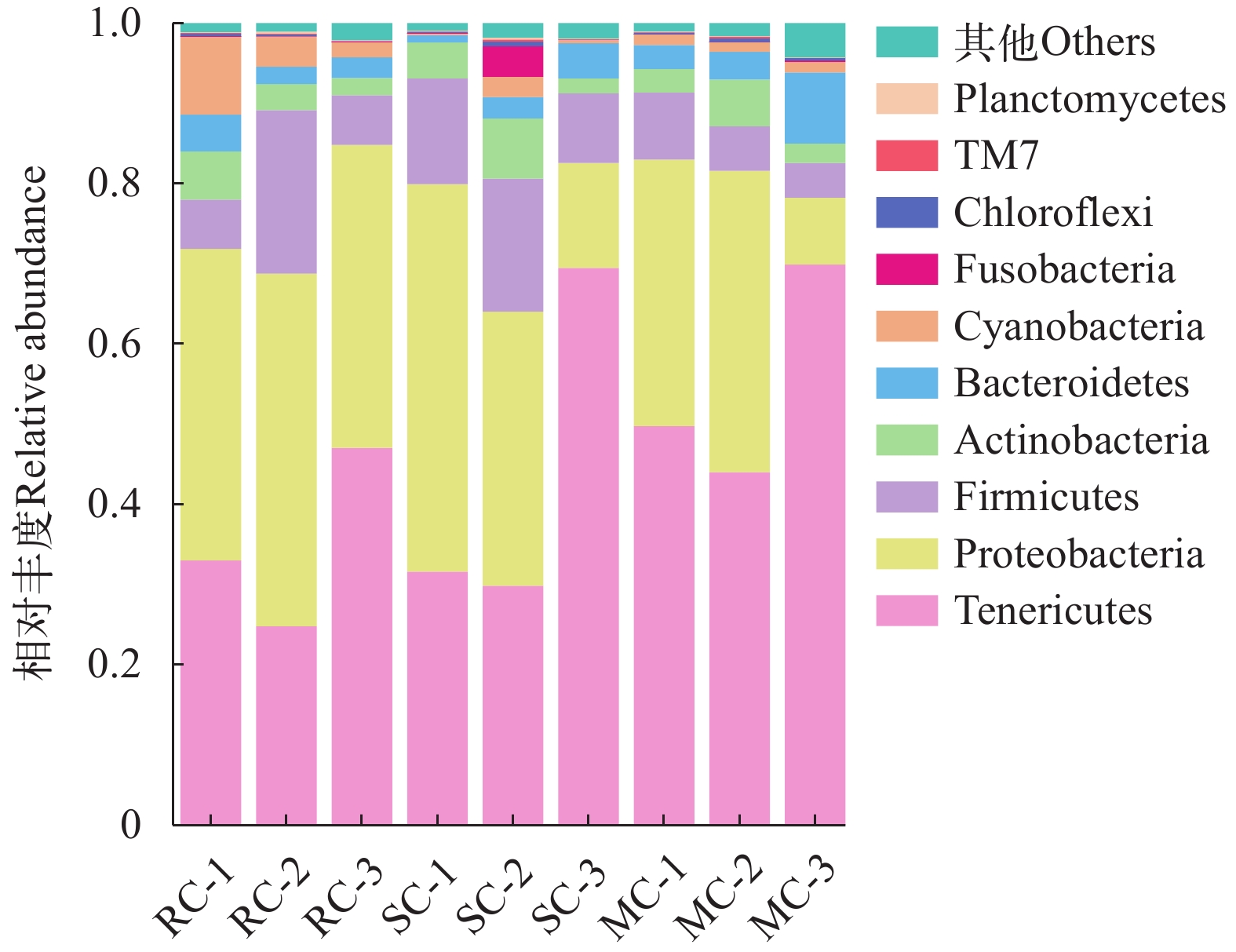
 下载:
下载:
